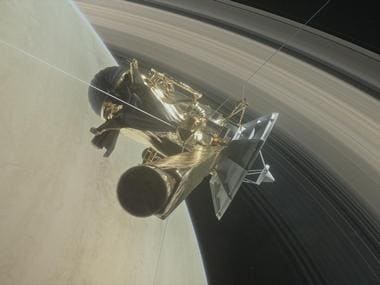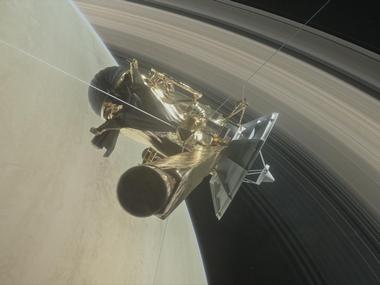Nasa’s Cassini probe is counting its final hours before one last plunge into Saturn on Friday (15 September) that will cap a fruitful 13-year mission that greatly expanded knowledge about the gas giant. [caption id=“attachment_3928159” align=“alignleft” width=“380”]  Cassini orbiting Saturn. NASA[/caption] While orbiting Saturn nearly 300 times, Cassini made major discoveries, such as the liquid methane seas of the planet’s giant moon Titan and the sprawling subsurface ocean of Enceladus, a small Saturn moon. “Cassini-Huygens is an extraordinary mission of discovery that has revolutionised our understanding of the outer solar system,” said Alexander Hayes, assistant professor of astronomy at Cornell University. **Data collected** by Cassini’s spectrometre while passing through a vapour plume at Enceladus’s south pole showed hydrogen shooting up through cracks in its ice layer. The gas was a sign of hydrothermal activity favourable to life, scientists said in April when they unveiled the finding. Launched in 1997 and equipped with a dozen scientific instruments, the 2.5-tonne probe entered Saturn’s orbit in 2004, landing on Titan in December of that year.
On April 22, it began the manoeuvres for its final journey. Moving closer to Titan, the spacecraft took advantage of the massive moon’s gravitational push to make the first of 22 weekly dives between Saturn and its rings, venturing for the first time into the uncharted 2,700-km space.
Cassini’s last five orbits will take it through Saturn’s uppermost atmosphere, before a final plunge directly into the planet on 15 September. Last Goodbyes Cassini flew by Titan one last time on Tuesday before transmitting images and scientific data from the flight. Mission engineers will use the information gathered from the encounter they dubbed “the goodbye kiss” to make sure the vessel is following the right path to plunge into the gas giant’s atmosphere. “The Cassini mission has been packed full of scientific firsts, and our unique planetary revelations will continue to the very end of the mission as Cassini becomes Saturn’s first planetary probe, sampling Saturn’s atmosphere up until the last second,” said Linda Spilker, Cassini project scientist at Nasa’s Jet Propulsion Laboratory in Pasadena, California. “We’ll be sending data in near real time as we rush headlong into the atmosphere, it’s truly a first-of-its-kind event at Saturn.” Cassini is expected to lose communications with Earth one or two minutes into its final dive, but 10 of its 12 scientific instruments will be working right up until the last moment to analyze the atmosphere’s composition. That data could help understand how the planet formed and evolved. On the eve of its final descent, other instruments will make detailed observations of Saturn’s aurora borealis, temperatures and polar storms. Grand finale Cassini’s final manoeuvres begin at 0714 GMT on Friday, although the signal will only reach Nasa 86 minutes later. At 1031 GMT, the spacecraft is due to enter Saturn’s atmosphere with its antennas pointed toward Earth and its motors running full blast in order to hold its trajectory. Just a minute later, at some 1,510km above Saturn’s clouds, the probe’s communications will stop before Cassini begins to disintegrate moments later, Nasa predicts. “The Grand Finale represents the culmination of a seven-year plan to use the spacecraft’s remaining resources in the most scientifically productive way possible,” said Earl Maize, Cassini project manager at the Jet Propulsion Laboratory. “By safely disposing of the spacecraft in Saturn’s atmosphere, we avoid any possibility Cassini could impact one of Saturn’s moons somewhere down the road, keeping them pristine for future exploration.” The mission is a cooperative project of Nasa, the European Space Agency (ESA) and Italy’s space agency. Nasa’s European and Italian partners built the Huygens probe Cassini carried until dropping it on Titan. The Cassini-Huygens mission’s total cost is about US$3.26 billion (S$4.4 billion), including US $1.4 billion for pre-launch development, US $704 million for mission operations, US $54 million for tracking and US $422 million for the launch vehicle. The United States contributed $2.6 billion to the project, the European Space Agency US$500 million and the Italian Space Agency US$160 million. Italian astronomer Giovanni Cassini **discovered four of Saturn moons** in the 17th century, although scientists have since identified more than 60. During the same era, Dutch mathematician Christiaan Huygens found that Saturn had rings. He also was the first person to observe Titan.


)



